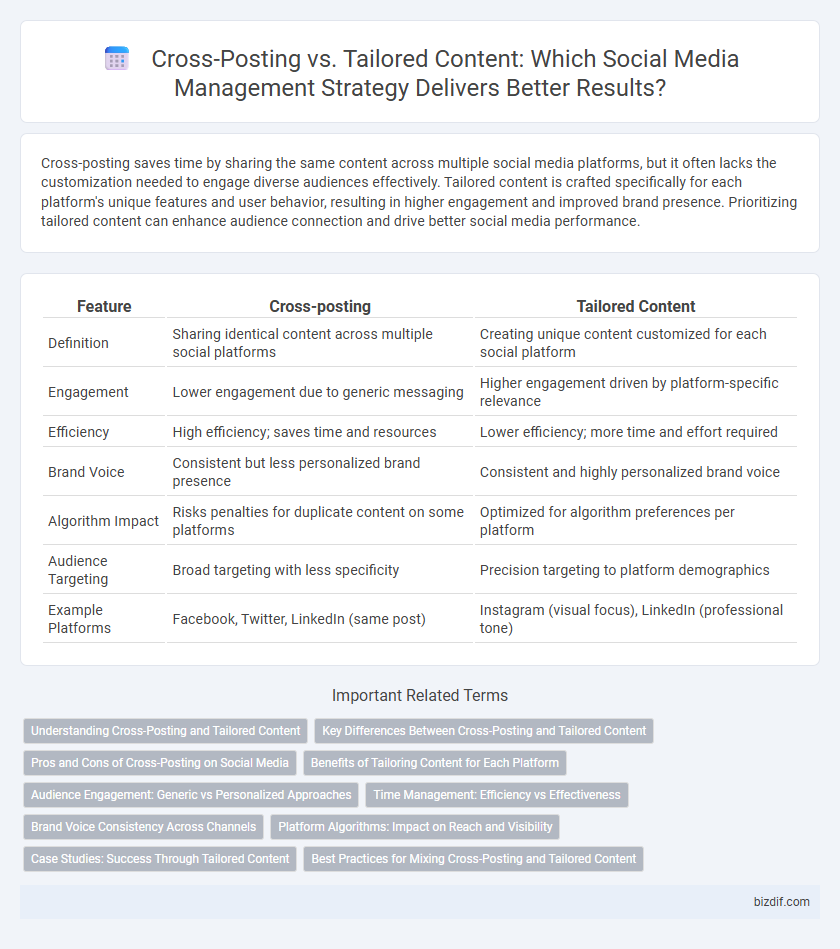Cross-posting saves time by sharing the same content across multiple social media platforms, but it often lacks the customization needed to engage diverse audiences effectively. Tailored content is crafted specifically for each platform's unique features and user behavior, resulting in higher engagement and improved brand presence. Prioritizing tailored content can enhance audience connection and drive better social media performance.
Table of Comparison
| Feature | Cross-posting | Tailored Content |
|---|---|---|
| Definition | Sharing identical content across multiple social platforms | Creating unique content customized for each social platform |
| Engagement | Lower engagement due to generic messaging | Higher engagement driven by platform-specific relevance |
| Efficiency | High efficiency; saves time and resources | Lower efficiency; more time and effort required |
| Brand Voice | Consistent but less personalized brand presence | Consistent and highly personalized brand voice |
| Algorithm Impact | Risks penalties for duplicate content on some platforms | Optimized for algorithm preferences per platform |
| Audience Targeting | Broad targeting with less specificity | Precision targeting to platform demographics |
| Example Platforms | Facebook, Twitter, LinkedIn (same post) | Instagram (visual focus), LinkedIn (professional tone) |
Understanding Cross-Posting and Tailored Content
Cross-posting involves sharing identical content across multiple social media platforms to save time and maintain consistent messaging, while tailored content is customized specifically for each platform's unique audience and format. Effective social media management requires balancing cross-posting to streamline workflow with tailored content to maximize engagement, as platforms like Instagram favor visual storytelling whereas LinkedIn prioritizes professional and detailed posts. Understanding the strengths and limitations of both strategies helps optimize reach and interaction across networks such as Facebook, Twitter, and TikTok.
Key Differences Between Cross-Posting and Tailored Content
Cross-posting involves sharing the same content across multiple social media platforms, maximizing reach with minimal effort but risking lower engagement due to platform-specific audience preferences. Tailored content is customized for each platform, enhancing user experience and interaction by addressing unique demographics, content formats, and algorithm priorities. Businesses leveraging tailored content typically see higher engagement rates and more effective brand messaging compared to those relying solely on cross-posting.
Pros and Cons of Cross-Posting on Social Media
Cross-posting on social media saves time and ensures consistent messaging across platforms, boosting brand visibility without extra content creation efforts. However, it risks reduced engagement due to platform-specific audience preferences and varying content formats that may not resonate equally. Brands must weigh efficiency against potential drops in relevance and interaction when choosing cross-posting strategies.
Benefits of Tailoring Content for Each Platform
Tailoring content for each social media platform enhances audience engagement by delivering messages that resonate with specific user behaviors and preferences. Customized posts improve algorithmic reach, increasing visibility and driving higher interaction rates compared to generic cross-posting. Platforms like Instagram favor visually rich content, while Twitter prioritizes concise, timely updates, making tailored strategies crucial for maximizing campaign effectiveness.
Audience Engagement: Generic vs Personalized Approaches
Cross-posting enables quick content distribution across platforms but often results in generic messaging that may reduce audience engagement. Tailored content, crafted to suit specific platform audiences, fosters higher interaction rates by addressing unique preferences and behaviors. Personalized approaches significantly boost user engagement metrics, such as likes, shares, and comments, by making content more relevant and relatable.
Time Management: Efficiency vs Effectiveness
Cross-posting saves time by enabling simultaneous content sharing across multiple platforms, maximizing efficiency with minimal effort. Tailored content, while more time-consuming, enhances engagement and relevance, increasing overall effectiveness in reaching specific audience segments. Balancing both approaches optimizes social media management, aligning time management priorities with strategic communication goals.
Brand Voice Consistency Across Channels
Maintaining brand voice consistency across social media channels requires balancing cross-posting with tailored content strategies. Cross-posting ensures message uniformity and saves time, but tailored content adapts language and tone to each platform's audience, enhancing engagement and brand perception. Prioritizing customized messaging aligned with core brand values strengthens overall brand identity while maximizing relevance on Facebook, Instagram, Twitter, and LinkedIn.
Platform Algorithms: Impact on Reach and Visibility
Platform algorithms prioritize tailored content by analyzing user engagement and relevance signals, resulting in higher reach and visibility compared to cross-posting generic messages. Cross-posting often leads to reduced algorithmic favorability due to its repetitive nature across different platforms, decreasing organic impressions and interactions. Optimizing content to fit each platform's unique audience and format significantly enhances algorithmic ranking, maximizing social media performance.
Case Studies: Success Through Tailored Content
Brands that implement tailored content in social media management experience significantly higher engagement rates, with case studies showing a 35% increase in audience interaction compared to cross-posting generic content. Tailored posts, designed to match platform-specific user behaviors and preferences, drive more conversions and foster stronger community loyalty. Data from platforms like Instagram and LinkedIn reveal that customized messaging aligns better with user expectations, boosting brand visibility and long-term ROI.
Best Practices for Mixing Cross-Posting and Tailored Content
Effective social media management balances cross-posting with tailored content by using cross-posting to maintain consistent messaging across platforms while customizing posts to fit each audience's preferences and platform algorithms. Utilizing platform-specific features such as Instagram Stories or LinkedIn articles enhances engagement and reach, whereas cross-posting saves time and ensures brand consistency. Analyzing performance metrics like engagement rates and click-throughs guides content strategy adjustments, optimizing the mix of cross-posted and tailored posts for maximum impact.
Cross-posting vs tailored content Infographic

 bizdif.com
bizdif.com